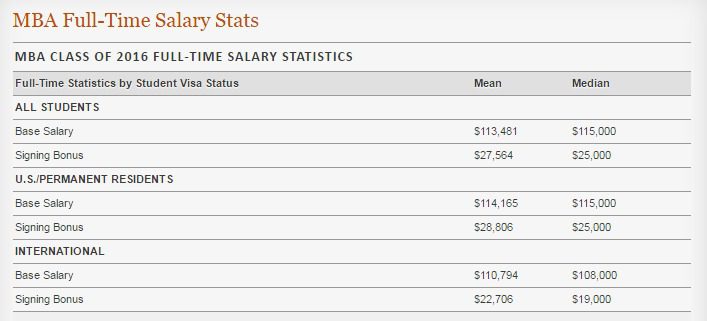Many students pursue an MBA with one goal—to improve their career opportunities. Whether you’re leveraging an MBA to transition into a different industry or to move up within your current company, it’s important to get a return on your academic (and financial) investment. So, how do you know if a particular MBA program is going to advance your progress toward your career goals? Reviewing a school’s MBA employment report is one of the best ways to assess a school’s potential to get you where you want to go.
Every year, MBA programs carefully track where their graduates head after earning their MBAs. These stats, which include salary details, top hiring firms and popular industries and job functions, provide a detailed overview of the job outcomes of their most recent MBA graduates. If reviewed carefully, these reports can give you a good sense of how well a particular MBA program will be in helping you land your dream job.
Recently, the McCombs School of Business released its 2016 Full-Time MBA Employment Statistics. We spoke to Stacey Rudnick, the director of MBA Career Management at McCombs, to get her perspective on which statistics are most important for prospective students to consider and what trends stood out this past year.

Clear Admit: What MBA employment report stats should students pay the most attention to?
Stacey Rudnick: Clearly, students should be paying attention to the overall employment percentage. But when you’re looking at the top-tier schools, we’re all strong in that measure. So, then it becomes about what you want to do and does that school perform well supporting your area of search.
I would pay attention to the industry and functional area that you want to be in and look specifically at who the top hiring firms are in that space. Then, choose a school that can help you with those relationships. [Employers’] relationships with each individual school are going to have a lot to do with where your greatest opportunities are for employment and the strength of the connections within the alumni network.
It all depends on the student. Some students come in and they’re exploring, but if you’re a student who knows exactly what you want to do, find out how well that school is going to support your specific search. The school should be able to answer the question, “What is your recruiting relationship within a particular category of companies—consulting firms, tech companies, banks, etc.—and who are your top firms within those areas?
CA: What were the most surprising or interesting stats from this year’s report?
SR: The most interesting stat is the high percentage of students (33 percent) that went into technology this year. There were a lot of things that contributed to this.
Technology is a growth industry for MBAs. There’s a lot more hiring of MBAs than there was ten years ago. Also, there’s tremendous interest in technology locally in Austin—Austin is a technology startup hub—but just as importantly we also have strong markets in California and Washington, which we’ve been actively working on for the last ten years. Those markets are starting to pay dividends for us in terms of the strength of our alumni network and the technology treks that we’ve continued to take and have been taking for years. It’s our tenth year doing the treks to both the Bay Area and Seattle.
We do pre-term treks in January and, this year, took 45 students to Seattle to visit Amazon, Microsoft, Starbucks and T-Mobile. Plus, we took a Bay Area trek with 40 students to see Facebook/Oculus, Oracle, Salesforce, Adobe, Twilio, SoFi, Flex, HPE and Google. There was record high student interest, and we bumped the cap on both treks to accommodate more students. In addition, we had two micro treks (10 to 15 students each) in the Bay Area to visit three gaming companies: Zynga, Electronic Arts and TinyCo, as well as a Clean Tech trek visiting companies such as PG&E, Nest and Bloom Energy. PlayStation will also be doing an on-campus event this spring.
So, high student interest, combined with good corporate partnerships and a strong alumni network, have made technology a burgeoning area for us and one that we’ve focused on both from a corporate outreach standpoint as well as trying to meet our students’ needs. I think it’s important to note, too, that while technology recruiting companies are background agnostic—they’ll take people from any background—a third of our students come from a technology background. Since so many of our students come to McCombs with technology as an interest or experience in the technology space, it is a natural choice after graduation.
Another thing that supports our high level of technology interest is the strong entrepreneurship culture in Austin and at the McCombs School. It draws in students that have an interest in entrepreneurship, innovation and product management, all of which have a strong overlap with technology.

CA: How many McCombs MBAs got a job offer within three months of graduation?
SR: Last year, 92 percent of the class received a job offer within three months of graduation. Job offers were up over the year before—when we were at 90 percent. We’re typically in that range —the low 90’s—because we have a high percentage of students seeking more entrepreneurial jobs. We think that being in the 90’s is a very high percentage and we don’t expect it to ever be at 98 percent because of those students seeking more entrepreneurial opportunities.
CA: What statistics increased this year?
SR: Job offers were up. And salaries were up specifically in consulting, technology, the energy sector and retail; those four industry areas experienced the highest percentage of increase. Also, our employment on the West Coast was up, unsurprisingly, because that encompasses California and Washington—our second-highest markets outside of Texas. Seventeen percent of our grads are going to the West Coast since last year.
Also, the number of students employed as brand and product managers increased this year; it went from 10 percent to 13 percent of the class over the last year. That increase reflects the product management jobs in the technology sector. While people are getting employed in technology in many different areas—operations, apps, etc.—product marketing and product management is one of the biggest parts of that.
CA: Final thoughts on employment stats?
SR: One of the things that I like to highlight about our class and community is how balanced we are as a program. Technology is an industry area but, functionally, we’re not just a finance or marketing school. We put a nice balance of students into consulting, operations, brand and product management and finance. We’re putting students into all of these categories compared to having a school where half the class is doing one particular functional area. I think that creates a great student culture and community because there’s such diversity among the class. It also means that the study teams are really balanced because you have people coming from different backgrounds and having different areas where they want to focus. I think that very positively mimics the work environments that they’re going to go into where, irrespective of what function you have, you’re going to be working with all different areas of the company.
This post has been republished in its entirety from its original source, metromba.com.




